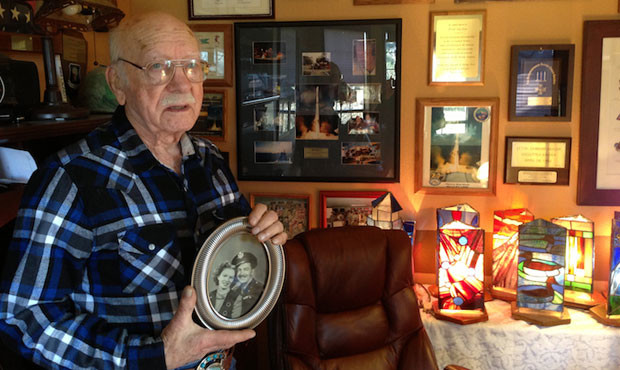Remembering Enumclaw’s Doolittle Raider Edward Saylor
Apr 18, 2024, 7:15 AM | Updated: 7:26 am

Edward Saylor, who passed away in 2015 at the age of 94, was a member of the April 18, 1942 Doolittle Raid on Japan. He lived in Enumclaw when KIRO Radio spoke with him in 2013. In his hand is a photo of him and his wife during World War II, and the wall is decorated with his stained glass creations honoring his old B-25 bomber. (Feliks Banel)
(Feliks Banel)
This story was originally published on April 18, 2014
The time was April 1942. Japan had attacked Pearl Harbor a few months earlier and the United States was at war. The situation was grim and the country needed a victory to boost morale.
Edward Saylor volunteered to be a flight engineer on a dangerous mission more than 80 years ago. Saylor grew up in rural eastern Montana and lived in Enumclaw for many years before passing away in January 2015. He spoke with KIRO Radio in 2013 about his time in the Army Air Force during World War II.
“I was just doing my job. I was no hero,” Saylor said. “I didn’t think what I’d done was all that big a deal because of the rest of the war.”
But it was a big deal.
Edward Saylor was a member of the legendary “Doolittle Raid.” In that famous attack, Colonel James Doolittle led a squadron of 16 B-25 “Mitchell” bombers from the deck of an aircraft carrier — an audacious tactic that had never been attempted before.
Their destination? Straight into the heart of industrial Japan.
As it turned out, dropping bombs on Kobe – Seattle’s future sister city – was the easy part.
More from Feliks Banel: Cold War air raid siren remains in private hands
Fearing detection by the Japanese after skirmishing with and sinking a ship off the coast of Japan, Doolittle had ordered the planes into the air earlier than planned. This meant that after dropping their payload, none of the bombers had enough fuel to safely reach friendly airbases in China.
So many had to be ditched in the ocean.
“The pilot said ‘We just have to land here in the water’ and that was the end of the conversation,” Saylor said.
“The airplane did really well, it was a belly landing,” Saylor said. “Bounced along the waves and came to a stop and floated for 10 minutes. And there wasn’t any training about water landings because it was too early in the war, you know, something nobody ever did or think about … water landings.”
Incredibly, Saylor and his crew managed to come safely ashore on a small island. With help from peasant farmers and fishermen, they evaded capture by the Japanese and made it to safety in China.
Meanwhile, back home in Tacoma, Saylor’s young wife Lorraine had heard all about the Doolittle Raid. The mission had achieved what it set out to do – show the American people that the United States could strike back against Japan, and boost morale on the home front. Lorraine Saylor and millions of Americans had read all about the attack in newspapers and seen newsreels at the movie theater.
There was just one thing, though. Lorraine Saylor had no idea that her own husband was involved in the action.
But she was about to find out.
More from Feliks Banel: Layers of history revealed by ‘Street Trees of Seattle’
“She was living with her parents and she went to a movie one afternoon, and they had those Movietone newsreels in those days … [the] primary source of news was in the theater,” Saylor said.
“And she was sitting there watching that newsreel, and I showed up on the newsreel. Madame Chiang Kai-shek pinning a medal on us big as life, right in front of her,” Saylor said.
“Oh boy, that was something for her,” he said, chuckling at the obviously fond memory of his late wife.
After the Doolittle Raid, Edward Saylor returned from Asia and then served in Europe for the rest of World War II. He made the Air Force his career during the Cold War.
Saylor was the fourth-to-the-last surviving member of the Doolittle Raid when he passed away in Jan. 2015 at age 94.
Final surviving Doolittle Raider Richard E. Cole died in 2019 at age 103. Ceremonies marking the anniversary of the audacious mission have continued to be held every year since.
You can hear Feliks Banel every Wednesday and Friday morning on Seattle’s Morning News with Dave Ross and Colleen O’Brien. Read more from Feliks here and subscribe to The Resident Historian Podcast here. If you have a story idea or a question about Northwest history, please email Feliks. You can also follow Feliks on X, formerly known as Twitter.













